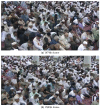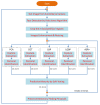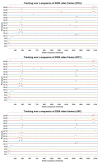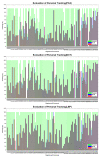A Novel Integration of Face-Recognition Algorithms with a Soft Voting Scheme for Efficiently Tracking Missing Person in Challenging Large-Gathering Scenarios
- PMID: 35161898
- PMCID: PMC8838238
- DOI: 10.3390/s22031153
A Novel Integration of Face-Recognition Algorithms with a Soft Voting Scheme for Efficiently Tracking Missing Person in Challenging Large-Gathering Scenarios
Abstract
The probability of losing vulnerable companions, such as children or older ones, in large gatherings is high, and their tracking is challenging. We proposed a novel integration of face-recognition algorithms with a soft voting scheme, which was applied, on low-resolution cropped images of detected faces, in order to locate missing persons in a challenging large-crowd gathering. We considered the large-crowd gathering scenarios at Al Nabvi mosque Madinah. It is a highly uncontrolled environment with a low-resolution-images data set gathered from moving cameras. The proposed model first performs real-time face-detection from camera-captured images, and then it uses the missing person's profile face image and applies well-known face-recognition algorithms for personal identification, and their predictions are further combined to obtain more mature prediction. The presence of a missing person is determined by a small set of consecutive frames. The novelty of this work lies in using several recognition algorithms in parallel and combining their predictions by a unique soft-voting scheme, which in return not only provides a mature prediction with spatio-temporal values but also mitigates the false results of individual recognition algorithms. The experimental results of our model showed reasonably good accuracy of missing person's identification in an extremely challenging large-gathering scenario.
Keywords: integration of face-recognition algorithms; large-crowd gatherings; soft voting scheme; tracking missing persons.
Conflict of interest statement
The authors declare no conflict of interest.
Figures























Similar articles
-
Tracking Missing Person in Large Crowd Gathering Using Intelligent Video Surveillance.Sensors (Basel). 2022 Jul 14;22(14):5270. doi: 10.3390/s22145270. Sensors (Basel). 2022. PMID: 35890950 Free PMC article.
-
Real-Time Gender Recognition for Juvenile and Adult Faces.Comput Intell Neurosci. 2022 Mar 17;2022:1503188. doi: 10.1155/2022/1503188. eCollection 2022. Comput Intell Neurosci. 2022. PMID: 35341170 Free PMC article. Review.
-
Coupled Attribute Learning for Heterogeneous Face Recognition.IEEE Trans Neural Netw Learn Syst. 2020 Nov;31(11):4699-4712. doi: 10.1109/TNNLS.2019.2957285. Epub 2020 Oct 29. IEEE Trans Neural Netw Learn Syst. 2020. PMID: 31940558
-
Learning Low-Rank Class-Specific Dictionary and Sparse Intra-Class Variant Dictionary for Face Recognition.PLoS One. 2015 Nov 16;10(11):e0142403. doi: 10.1371/journal.pone.0142403. eCollection 2015. PLoS One. 2015. PMID: 26571112 Free PMC article.
-
Recognizing People in Motion.Trends Cogn Sci. 2016 May;20(5):383-395. doi: 10.1016/j.tics.2016.02.005. Epub 2016 Mar 24. Trends Cogn Sci. 2016. PMID: 27016844 Review.
Cited by
-
Tracking Missing Person in Large Crowd Gathering Using Intelligent Video Surveillance.Sensors (Basel). 2022 Jul 14;22(14):5270. doi: 10.3390/s22145270. Sensors (Basel). 2022. PMID: 35890950 Free PMC article.
-
Analysis of Real-Time Face-Verification Methods for Surveillance Applications.J Imaging. 2023 Jan 18;9(2):21. doi: 10.3390/jimaging9020021. J Imaging. 2023. PMID: 36826940 Free PMC article.
References
-
- Huang G.B., Ramesh M., Berg T., Learned-Miller E. Labeled Faces in the Wild: A Database for Studying Face Recognition in Unconstrained Environments. University of Massachusetts; Amherst, MA, USA: 2007.
-
- Kumar N., Berg A.C., Belhumeur P.N., Nayar S.K. Attribute and simile classifiers for face verification; Proceedings of the 2009 IEEE 12th International Conference on Computer Vision. IEEE; Kyoto, Japan. 29 September–2 October 2009; pp. 365–372.
-
- Pasztor E., Carmichael O.T. Learning low-level vision. Int. J. Comput. Vis. 2000;40:25–47.
-
- Liu Z., Luo P., Wang X., Tang X. Large-scale celebfaces attributes (celeba) dataset. Retrieved August. 2018;15:11.
-
- Wolf L., Hassner T., Maoz I. Face recognition in unconstrained videos with matched background similarity; Proceedings of the CVPR 2011; Colorado Springs, CO, USA. 20–25 June 2011; pp. 529–534.
MeSH terms
Grants and funding
LinkOut - more resources
Full Text Sources

